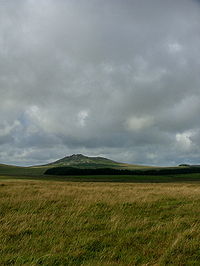
Brown Willy effect
Encyclopedia

Meteorology
Meteorology is the interdisciplinary scientific study of the atmosphere. Studies in the field stretch back millennia, though significant progress in meteorology did not occur until the 18th century. The 19th century saw breakthroughs occur after observing networks developed across several countries...
phenomenon that sometimes occurs across the south-west peninsula
Peninsula
A peninsula is a piece of land that is bordered by water on three sides but connected to mainland. In many Germanic and Celtic languages and also in Baltic, Slavic and Hungarian, peninsulas are called "half-islands"....
of Britain
United Kingdom
The United Kingdom of Great Britain and Northern IrelandIn the United Kingdom and Dependencies, other languages have been officially recognised as legitimate autochthonous languages under the European Charter for Regional or Minority Languages...
. It leads to heavy showers
Precipitation (meteorology)
In meteorology, precipitation In meteorology, precipitation In meteorology, precipitation (also known as one of the classes of hydrometeors, which are atmospheric water phenomena is any product of the condensation of atmospheric water vapor that falls under gravity. The main forms of precipitation...
developing over the high ground of Bodmin Moor
Bodmin Moor
Bodmin Moor is a granite moorland in northeastern Cornwall, England, United Kingdom. It is in size, and originally dates from the Carboniferous period of geological history....
in Cornwall
Cornwall
Cornwall is a unitary authority and ceremonial county of England, within the United Kingdom. It is bordered to the north and west by the Celtic Sea, to the south by the English Channel, and to the east by the county of Devon, over the River Tamar. Cornwall has a population of , and covers an area of...
, which then often travel a considerable distance downwind of their place of origin. It is named after the hill, Brown Willy
Brown Willy
Brown Willy is a hill in Cornwall, United Kingdom. The summit is the highest point of Bodmin Moor and of Cornwall as a whole....
, the highest point on the moor and in Cornwall as a whole. It is thought that the Boscastle flood of 2004
Boscastle flood of 2004
The Boscastle flood of 2004 occurred on Monday, 16 August 2004 in the two villages of Boscastle and Crackington Haven in Cornwall, England, United Kingdom. The villages suffered extensive damage after flash floods caused by an exceptional amount of rain that fell over eight hours that afternoon...
was caused by a particularly extreme example of the effect.
Causes
Cornwall lies in the path of prevailing mild, moist westerly or south-westerly winds that blow in from the Atlantic OceanAtlantic Ocean
The Atlantic Ocean is the second-largest of the world's oceanic divisions. With a total area of about , it covers approximately 20% of the Earth's surface and about 26% of its water surface area...
. As these hit land, they are slowed by the effect of friction. Because Cornwall is a relatively narrow peninsula, winds near the south coast tend to be diverted to a more northerly direction, whilst winds near the north coast tend to be diverted southwards. This leads to a convergence of winds near the central spine of the peninsula, leading to uplift and condensation of the moisture borne by them. The uplift is intensified by the altitude of the land on Bodmin Moor.
Furthermore, in the summer, the land heats more than the sea, which causes sea breezes to establish during the day, increasing convergence still further. Converging sea breeze fronts from the north and south coasts of Cornwall can lead to very rapid convection developing over the moor, which can result in very heavy showers or thunderstorms.
Once the showers have formed, they often travel in an easterly or north-easterly direction, driven by the prevailing wind. This can cause a thin line of showers to occur along the length of the south-west peninsula, all originating from the Brown Willy area. Places directly in the path of these showers can suffer a series of heavy downpours, whilst nearby locations remain dry. On March 27, 2006, a continuous line of showers stretched from Brown Willy to Burford, Oxfordshire — a distance of about 145 miles (232 km).
Effects
The effect of this process can be anything from heavy rain to forceful flash floods, like those seen at BoscastleBoscastle flood of 2004
The Boscastle flood of 2004 occurred on Monday, 16 August 2004 in the two villages of Boscastle and Crackington Haven in Cornwall, England, United Kingdom. The villages suffered extensive damage after flash floods caused by an exceptional amount of rain that fell over eight hours that afternoon...
in 2004. The rainfall falls onto the small waterbasin of the many rivers in the south-west. The water is absorbed into the ground, flows to the river and gradually fills it up; when the ground becomes saturated, i.e. it cannot hold anymore water, the water flows over the ground and is called surface runoff. When the river bursts its bank the floodplain is covered with river and rainwater causing damage, dismay and even death to towns and villages alike.

